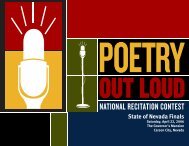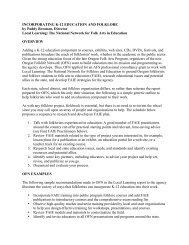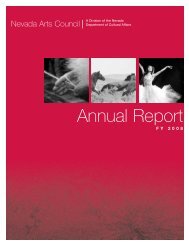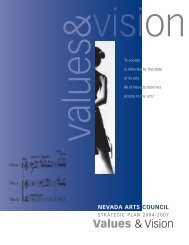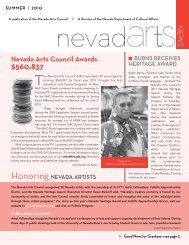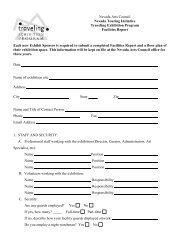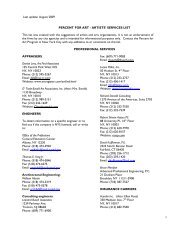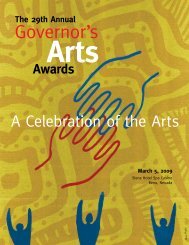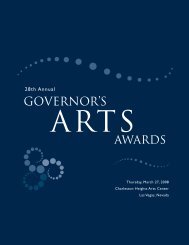WHAT CONTINUES THE DREAM: - Nevada Arts Council
WHAT CONTINUES THE DREAM: - Nevada Arts Council
WHAT CONTINUES THE DREAM: - Nevada Arts Council
Create successful ePaper yourself
Turn your PDF publications into a flip-book with our unique Google optimized e-Paper software.
<strong>WHAT</strong> <strong>CONTINUES</strong> <strong>THE</strong> <strong>DREAM</strong>:<br />
Contemporary <strong>Arts</strong> and Crafts from the Powwow Tradition
ooooooooooo<br />
Princess crown, the<br />
Numaga Indian Days<br />
Powwow in Reno,<br />
made by Dean Barlese.<br />
When Indians were placed on reservations, there was a bloom of artwork…because the only<br />
freedom they had was in their minds. It was an incredible time. They were conquered and<br />
abused, no longer wanted on the face of the earth, and they took off and created great pieces<br />
of artwork. It was just tremendous. I’d like to see something like that shown as a tribute, not<br />
just to Native Americans, but to mankind, to what can happen when you want to survive.<br />
When you physically feel unable to, what makes you sing? What gives you hope? What<br />
continues the dream?<br />
—Alfreda Mitre, Southern Paiute<br />
From Songs for Asking: Perspectives on Traditional Culture Among <strong>Nevada</strong> Indians,<br />
Nicholas CP Vrooman. <strong>Nevada</strong> State <strong>Council</strong> on the <strong>Arts</strong>, 1997.<br />
What Continues the Dream: Contemporary <strong>Arts</strong> and Crafts from the Powwow Tradition<br />
A special thanks to all the Native American<br />
artists featured in this exhibition!<br />
Rattle<br />
Kenny Anderson<br />
Southern Paiute<br />
Medicine Bottle<br />
William Astor<br />
Washo/Northern Paiute/<br />
Western Shoshone<br />
Dance Collar<br />
Arlene Austin<br />
Northern Paiute<br />
Powwow Princess Crowns, Medallion<br />
Dean Barlese<br />
Northern Paiute<br />
Girl’s Powwow Fan<br />
John Bear<br />
Choctaw/Apache<br />
Grass Dancer (mixed media)<br />
Wayne Allen Burke<br />
Northern Paiute<br />
Bracelet<br />
Lynnaya Comas<br />
Washo/Northern Paiute/Wintu<br />
Feather Motif Necklace,<br />
Dance for Life (mixed media)<br />
Cassandra Leigh Darrough<br />
Northern Paiute<br />
Dreamcatcher<br />
Deanna Domingo<br />
Southern Paiute<br />
Basket Motif Necklace<br />
Ryan Dunn<br />
Northern Paiute/Western Shoshone<br />
Gift Baskets<br />
Rebecca Eagle<br />
Northern Paiute/Western Shoshone<br />
Horse Motif Dance Stick<br />
Adam Fortunate Eagle<br />
Chippewa<br />
Color print (untitled)<br />
Gordon Gibson<br />
Northern Paiute/Western Shoshone<br />
Drumstick<br />
Donald “Ike” Hicks<br />
Northern Paiute/Western Shoshone<br />
Cell Phone Holder<br />
Linda Johnson-Comas<br />
Washo/Northern Paiute<br />
Miniature Hand Drum<br />
Steve Mike<br />
Western Shoshone<br />
Miniature Buckskin War Shirt<br />
Bobbie Nordwall<br />
Western Shoshone<br />
Porcupine Hair Roach<br />
Ken Paul<br />
Northern Paiute<br />
Elk Antler Medallion<br />
Burton Pete<br />
Northern Paiute<br />
Medicine Pouch, Moccasins, Rattle,<br />
Women’s Regalia Set<br />
Angie Quintana<br />
Western Shoshone<br />
Shoshone Rose Motif Belt and Loom<br />
Debra Reed<br />
Shoshone/Northern Paiute/Ute<br />
Hand Drum<br />
Michael Rojas<br />
Terascan<br />
Dress, Traditional Style<br />
Francine Tohannie<br />
Western Shoshone
oooooooooooooooooooooooooooooooooooooooooooooooooooooooooooooooooooooooooooooooooooooooooooooooooooooooooooooooooooooooooooooooo<br />
The contemporary intertribal powwow is a relatively new cultural phenomenon in <strong>Nevada</strong>. It has sprung to life during the past half-century from roots that run deep<br />
into <strong>Nevada</strong> soil and extend far beyond the borders of the state. Each year, powwows are presented statewide on tribal lands ranging from the Duck Valley Indian<br />
Reservation on the <strong>Nevada</strong>-Idaho border to the Fort Mojave Indian Reservation that straddles the state lines between <strong>Nevada</strong>, Arizona, and California. In many<br />
communities, the powwow is an annual event that brings people together to socialize and celebrate community spirit, honor traditional values, engage in friendly<br />
competition for prizes and recognition, and share pride of culture and community with each other and with outsiders.<br />
ooooooooooo<br />
Sunset overtakes the Snow Mountain Powwow<br />
grounds northwest of Las Vegas (right);<br />
roadside sign points the way (left).<br />
Photos by Rebecca Snetselaar.<br />
bringing the people home…<br />
On July 24–26, 2009, Big Bend Ranch was filled with<br />
dancers and spectators from many states and from overseas…<br />
Bringing the People Home was our goal, and<br />
we hope to continue to do so in the years to come.<br />
We have been given this earth to protect and to share,<br />
carrying on our traditions while sharing the experience.<br />
Together we build, strive, and persevere.<br />
Together we are one community.<br />
—1st Annual Sacred Visions Pow-wow Committee<br />
“Sacred Visions Powwow,” Numuwaetu Nawahana: Telling the Indian People’s News, the Pyramid Lake Paiute<br />
Tribal Newspaper, Volume XIII, Issue 9, September, 2009.
POWWOW: A BRIEF HISTORY<br />
The word powwow is derived from the Algonquian word pauwau or pauau. It passed into use by English speaking immigrants in the 1600s on the<br />
eastern coast of North America. This word was associated with holy men, shamans, priests – elders whose powerful dreams provided spiritual<br />
guidance, curative powers, and supernatural insights. Ceremonials, feast days and other gatherings were associated with these individuals.<br />
Eventually, the term came to describe almost any ceremony or gathering by Native Americans, and over time its meaning broadened to include<br />
any informal “get-together” such as a party, meeting, or group discussion.<br />
Staff and volunteers worked together to make a moose hide drum for the Las Vegas<br />
Indian Center. “The drum is the heartbeat of our Native Nations and it is a cultural<br />
tradition and a great honor for native communities to have their own drum,” noted<br />
LVIC Executive Director Debra Reed. Photo by Rebecca Snetselaar.<br />
ooooooooooo<br />
better to make it…<br />
It’s better to make it than to buy it,<br />
because your time is really important.<br />
When you honor, it’s better that it’s made<br />
by you or your family member.<br />
I make earrings and do beadwork and make dream<br />
catchers... and now I know how to make quilts. One<br />
of my grandsons died two years ago, and we had a<br />
memorial for him and she [Edna Mae Johnson] made<br />
a lot of the quilts, and that’s when I decided I wanted<br />
to learn. A lot of my family were dancers, too, and if<br />
somebody asked them to be head dancer or something,<br />
we always liked to give some quilts away for that, too,<br />
for giveaways at a powwow.<br />
<strong>Nevada</strong> Folklife Archives # C980801, Sept. 2, 1998,<br />
interview by Andrea Graham.<br />
—Karen Wahwasuck, Potawatomi
oooooooooooooooooooooooooooooooooooooooooooooooooooooooooooooooooooooooooooooooooooooooooooooooooooooooooooooooooooooooooooooooo<br />
Between 1880 and the mid-1930s, the ability of American Indian people to gather in public to celebrate traditional social or religious occasions was being curtailed.<br />
The “Civilization Regulations” and related policies were enforced in <strong>Nevada</strong> and other western states by federal government agents. These policies prohibited<br />
Native American dancing, religious ceremonies, traditional gatherings, and other cultural practices on reservation lands and at far-off boarding schools where school<br />
age children were being sent to learn “white man’s ways.”<br />
At the same time, the American public was being entertained by “show Indians,” recruited and paid to perform at expositions, fairs, and tourist attractions. Tribes<br />
and individuals steadfastly continued to honor cultural and spiritual practices and beliefs, and to pass traditional knowledge on to the next generation, but these<br />
activities took place in private and under a cloak of secrecy to avoid the threat of punishment or imprisonment.<br />
dancing in the<br />
face of injustice…<br />
My portraits embrace the pride, sorrow,<br />
and humility that all people experience;<br />
Men, women, and children of all cultures<br />
embracing triumph,<br />
praying for strength,<br />
and dancing in the face of injustice.<br />
My portraits celebrate the human condition in defeat<br />
and triumph, and the honor of both,<br />
the marks that we bear as the signs of competitors.<br />
So, to my family, friends, and those who worship, fight,<br />
and dance with honor—<br />
Believe…<br />
Artist’s biography, Holymen-Warriors-Dancers website,<br />
http://www.holymenwarriorsdancers.com, May 2010.<br />
—Wayne A. Burke, Northern Paiute<br />
Grass Dancer, by Wayne Allen Burke,<br />
mixed media (canvas, feathers, acrylic).<br />
Photo by Jeanette McGregor,<br />
courtesy of the <strong>Nevada</strong> State Museum.<br />
ooooooooooo
Historians cite the Ponca Powwow of 1879 in the newly-formed Indian Territory (now eastern Oklahoma) as the first public event to gather members<br />
of many different tribes – 67 tribes were resident in Indian Territory at the time – to participate in an exhibition of dancing, drumming and singing, in<br />
a circular arena, in the style of the modern day powwow.<br />
By the turn of the 20th century, tribes in other states were using the word powwow to describe similar events that welcomed participation by other tribes<br />
and encouraged attendance by the general public. These events featured local dances and regalia mixed with more flamboyant and showy Northern<br />
Plains styles. At the same time, tribes continued to gather privately for social, religious, and ceremonial occasions.<br />
making my own…<br />
ooooooooooo<br />
Women’s traditional Paiute<br />
beaded collar in traditional colors,<br />
made by Arlene Austin.<br />
I was born and raised in Reno, until I was<br />
about 16, and then I went to school in<br />
Brigham City, in Utah. It’s a boarding school.<br />
I got to meet other kids from all over. A lot of<br />
them spoke their language and had their own<br />
tribal dresses and when I looked at myself,<br />
being an urban Indian, there was nothing.<br />
So, when I met my husband…his grandma had her own<br />
traditional dress, and she was collecting beads and<br />
she’d give me lots of beads. And being an artist myself,<br />
I could look at something and get the basic design.<br />
So being exposed to those different things, with my<br />
interest in it, I just started making my own dresses.<br />
Girl’s traditional style dress<br />
decorated with cowrie shells,<br />
made by Francine Tohannie.<br />
ooooooooooo<br />
– Francine Tohannie, Western Shoshone<br />
<strong>Nevada</strong> Folklife Archives # C970601, March 8, 1997,<br />
interview by Andrea Graham.
oooooooooooooooooooooooooooooooooooooooooooooooooooooooooooooooooooooooooooooooooooooooooooooooooooooooooooooooooooooooooooooooo<br />
Passage of the Indian Reorganization Act in 1934 marked the beginning of a new era in <strong>Nevada</strong>’s Indian Territory. Tribes were once again free to organize<br />
ceremonies and gatherings openly. While they were adjusting to dramatic changes wrought by this “Indian New Deal,” another challenge materialized – one<br />
that would have far-reaching consequences in Indian Country. Nearly 45,000 Native Americans served in the United States Armed Forces during World War II.<br />
Another 40,000 men and women left their reservations and migrated to the cities to take jobs in defense-related industries. This was the first mass integration of<br />
Native Americans off the reservation into mainstream society in American history.<br />
In 1952, the Bureau of Indian Affairs introduced the Urban Indian Relocation Program and began moving people off the reservation and into jobs in Chicago,<br />
Denver, Los Angeles, San Francisco, San Jose, St. Louis, Cincinnati, Cleveland, and Dallas. Over the next 30 years an estimated 750,000 Native Americans migrated<br />
to the cities. According to census estimates, by the year 2000, 64 percent of American Indians were living off the reservation and in urban environments, compared<br />
to 8 percent in 1940.<br />
to celebrate life…<br />
For years, Native people have danced as a<br />
form of prayer and way to celebrate life.<br />
There is a movement among Native people to raise<br />
awareness of cancer.<br />
The dancer represents a friend, a family member –<br />
a person we all know.<br />
Dance honors the spirit of people.<br />
The shawl honors the spirit of hope, while the many<br />
colors of ribbon fringe represent the different types<br />
of cancer.<br />
—Cassandra Leigh Darrough,<br />
Northern Paiute/Western Shoshone<br />
“Community Health Representatives Speak Out About Cancer: An Invitation to<br />
Listen, A Call to Action,” The Indian Health Service Primary Care Provider, Vol. 34,<br />
No. 1, March, 2009<br />
Fancy Shawl dancer,<br />
2003 Snow Mountain Powwow.<br />
Photo by Lindsay Hebberd.<br />
ooooooooooo
During this period in American history, a “pan Indian” sense of community developed between and among Native Americans from different tribes in<br />
similar circumstances. The intertribal powwow evolved as a place where people of all tribal affiliations could come together for fellowship, to honor<br />
ancestors and elders, and to share traditional values and pride of heritage with the younger generation.<br />
Today, powwows are celebrated and recognized as powerful expressions of creativity, individuality, community and survival. We Are Still Here – the title of<br />
a radio program produced for the National Museum of the American Indian’s 2002 Inaugural Powwow in Washington D.C. – echoes an often-expressed<br />
sentiment as tribes continue to counter the myth of the “Vanishing Indian” that guided 150 years of policy-making in the United States.<br />
Dancers circle the arena at the<br />
Snow Mountain Powwow.<br />
Photo by Rebecca Snetselaar.<br />
ooooooooooo<br />
watching my<br />
daughters dance…<br />
I was taught the process of skinning the hide<br />
off the deer by my father. Hide work is very<br />
hard work. You must soak the hide and scrape it<br />
entirely. Eventually the work is finally done with<br />
consistently working and stretching the hide.<br />
My desire was to complete my first hide to make a<br />
buckskin dress for my wonderful wife Danena and my<br />
three daughters. I completed this project with much joy<br />
and ambition.<br />
My greatest accomplishment was beading my three<br />
daughters’ head crowns, belts, leggings, and beaded<br />
moccasins.<br />
Watching my daughters dance in local and outside<br />
powwows in the beautiful outfits that I designed made<br />
me feel very proud.<br />
<strong>Nevada</strong> Folklife Archives, Reference Collection.<br />
Folklife Apprenticeship Grants, 2009.<br />
—Roger Ike, Western Shoshone
oooooooooooooooooooooooooooooooooooooooooooooooooooooooooooooooooooooooooooooooooooooooooooooooooooooooooooooooooooooooooooooooo<br />
POWWOW: <strong>THE</strong> EXPERIENCE<br />
Today’s intertribal powwow showcases the creativity, vitality, and artistry of Native American arts and culture in the 21st Century. Drawing from traditional forms<br />
and inspired by traditional values, many <strong>Nevada</strong> residents who take pride in their Native American heritage contribute to these events. They create elaborate<br />
regalia, teach young people to perform and compete, learn songs that are appropriate to particular dances or occasions, take seats in the drum circle, and dance in<br />
the footsteps of their ancestors.<br />
Handmade arts and crafts are often a featured attraction, and people stand in line at food booths where “Indian Fry Bread” or “Indian Tacos” are served. Individuals<br />
and families may “take to the powwow trail,” driving long distances to participate as visiting drum groups, enter dance competitions, or sell arts and crafts while<br />
visiting with family and friends from other counties or states.<br />
The powwow schedule begins with the Grand Entry, led by an honor guard of armed forces veterans carrying the eagle staffs and flags, followed by honored guests<br />
such as tribal officials and princesses crowned at recent powwows. The Head Man and Head Woman lead the dancers into the arena. After a prayer and blessing,<br />
all are invited to participate in an intertribal “social” dance. Contest dances follow. If the powwow continues into the evening or lasts several days, additional Grand<br />
Entries are scheduled after the dinner break, or to open each subsequent day of the event.<br />
from the heart<br />
and with honor…<br />
We are singers for a few simple reasons.<br />
We sing for the people, the dancers,<br />
and those who have come before us,<br />
always remembering that respecting the drum,<br />
each other,<br />
and our beliefs should hold true,<br />
above and beyond anything else,<br />
and that we should sing from the heart and with honor,<br />
rather than for the fame and glory.<br />
<strong>Nevada</strong> <strong>Arts</strong> <strong>Council</strong> Folklife Program,<br />
Correspondence Files, 2010.<br />
—Martin Montgomery, Washo<br />
Lead singer, Red Hoop<br />
The Honor Guard leads the<br />
Grand Entry at the Stewart<br />
Fathers’ Day Powwow 2008.<br />
Photo by Patricia Atkinson.<br />
ooooooooooo
Men’s competition categories include Fancy Dance, Traditional, and Grass Dance; women compete in Fancy Shawl, Traditional, and Jingle Dance<br />
categories. There are many other dances that may be featured, some of them competitive and others that are open to all. In the competitive dances,<br />
dancers compete by age group for cash prizes under the watchful eye of the Head Man and Head Woman who have been chosen by the powwow<br />
committee. Everyone attending the powwow is welcome to enter the arena and dance when the Master of Ceremonies announces an “intertribal” dance<br />
such as the Round Dance.<br />
Most powwows feature a Powwow Princess competition. Competitors may be judged on regalia, dancing, ticket sales, and other criteria. The Princess<br />
receives a beaded crown and serves as an ambassador for her community or tribe at other powwows and events throughout the year. Hand drum<br />
competitions may also be featured as part of the program.<br />
“The drum” is a group of performers who gather around a large drum to play and sing. The Host Drum attends by invitation, and many powwows feature<br />
the different Northern and Southern styles of drumming by having a host drum from each. Drums that have not officially been invited are welcome to<br />
make a place for themselves around the circle. They play in rotation, or take turns under the direction of the Arena Director and Master of Ceremonies.<br />
Some drums have earned a following on the powwow circuit and offer CDs for sale.<br />
sharing my culture…<br />
I danced with a group at the elementary<br />
school on my reservation. We did mostly<br />
Paiute dances and I wore a buckskin dress<br />
made by my great grandmother, but I always<br />
wanted to do the more athletic, exciting fancy<br />
shawl dance, to compete in powwows.<br />
This hand drum, made from a mail-ordered frame and moose hide by<br />
Michael Rojas, is decorated with the Las Vegas Indian Center logo.<br />
The drumstick was made by Donald “Ike” Hicks, who used<br />
brain-tanned buckskin that he processed in the traditional way.<br />
ooooooooooo<br />
In traveling and sharing my culture, I have found that<br />
people are interested in what we, as native people, have<br />
to say. Much of the world knows about our past, but<br />
they don’t know what our everyday lives look like.<br />
I do not believe we are ever going to be fully<br />
acculturated, because of our values and how we grow<br />
up. We may speak English but our hearts have a<br />
language all their own and so do our traditions.<br />
—Michelle McCauley,<br />
Paiute/Shoshone/Washo/Quinault<br />
“Entering My First Pageant Ever,” Native Youth Magazine L. L. C. – The Online<br />
Magazine for Native Youth, April 19, 2006.
oooooooooooooooooooooooooooooooooooooooooooooooooooooooooooooooooooooooooooooooooooooooooooooooooooooooooooooooooooooooooooooooo<br />
Regalia are always unique to the individual dancer and constitute a personal expression of artistry, identity, and creativity. “Powwow” means different things to<br />
different people, even within families or tribes. The significance of the powwow to an individual may be influenced by tribal affiliations, family connections, spiritual<br />
beliefs, personal circumstances, and myriad other factors. Dancers dress in regalia appropriate to specific competitive or social dances, but personalized in ways that<br />
have special meaning to the wearers.<br />
Dance regalia may be homemade or purchased, and may utilize traditional or contemporary materials. Patterns and colors are chosen for personal, family, or tribal<br />
significance. Some dancers wear heirloom pieces that have been passed down in their families. Many make regalia for themselves and family members. Some pieces<br />
are made for sale and purchased locally, at a powwow, or on the internet.<br />
Powwow cannot represent one single “Native American” culture; that does not exist. Powwow represents the blending and mixing of traditions from the many<br />
different tribes and cultures present in North America throughout its history. Powwow is an expression of contemporary living communities, not historical ones.<br />
As such, it reflects intricate and complex relationships between and among people who honor and celebrate their own tribal culture, heritage and identity. Many<br />
different traditions are represented and respected as part of “powwow tradition.”<br />
to show respect…<br />
At the intertribal powwow, all people are welcome to<br />
watch and participate.<br />
If you are enrolled in a recognized tribe, you can have eagle feathers<br />
in your dance regalia. For others, because eagles are endangered<br />
species, it’s against the law to have them. Different tribes have their<br />
own ways, but eagle feathers are often given to people or families by<br />
their tribe, to show respect.<br />
So, at a powwow, you pay respect to a dancer who has eagle feathers<br />
because he’s earned them, like guys who have come back from the<br />
military, from fighting in a war. I was taught to respect the medicine<br />
the eagle provides, and that when you receive feathers, everything of<br />
your being goes into them.<br />
When I was younger, when I danced in my bustle and head roach, my<br />
fan and my dance stick in my hand, before I performed, I tugged on all<br />
my feathers and if there was one that was loose, I’d put it back in my<br />
bag and then go out there. To drop a feather in the arena, after the<br />
grounds have been blessed, I was taught, that’s the most disrespectful<br />
thing you can do as far as eagle is concerned.<br />
Interviewed by Rebecca Snetselaar, May 4, 2010, Henderson, NV.<br />
– John Bear, Choctaw/Apache<br />
Dancers at the 2010<br />
Snow Mountain Powwow.<br />
Photo by Rebecca Snetselaar.<br />
ooooooooooo
Plains Influence: Some of the regalia worn by men at a powwow are historically associated with warrior societies of the Great Plains tribes in<br />
the 1800s.<br />
z The man’s hair roach in this exhibition is made from porcupine and horse hair on a woven spine, with strings attached to tie under the chin. Feather<br />
plumes are added as decoration, or to signify honors earned.<br />
z The showy bustle worn by Fancy Dancers, with feathers dyed in brilliant colors to match the dancer’s beadwork, is an adaptation of a relatively austere<br />
feather bustle worn by some dancers in the Men’s Traditional category.<br />
Beadwork: Colorful and intricate, beadwork takes many forms. Some traditional colors and designs are associated with particular cultures.<br />
z The Shoshone Rose motif on the beaded belt in this exhibition is an indication that the wearer identifies with the Shoshone culture.<br />
z Dancers in the Women’s Traditional category may wear a beaded collar that is historically associated with Great Basin tribes. The one in this exhibition<br />
is made in “traditional” colors – red, white and blue – and adorned with abalone shell discs.<br />
Buckskin: The use of deer hide in clothing and other pieces of regalia is traditional in the Great Basin and many other areas of the United States.<br />
z Making a dress or a war shirt, like the one represented by a framed miniature in this exhibition, is no small task. Working with hides requires the mastery<br />
of special skills and techniques. It can also be a costly undertaking as three to five hides are required to complete such a project.<br />
z The child-size, high-top moccasins in the exhibition are handmade from buckskin that was brain-tanned and smoked “in the traditional way” by the<br />
artist’s father. Smoking gives the buckskin its maize coloring and imparts the unmistakable essence of wood smoke.<br />
ooooooooooo<br />
Jingle dancer at the 2010<br />
Snow Mountain Powwow.<br />
Photo by Rebecca Snetselaar.<br />
Feathers and a mirror adorn this<br />
feather bustle, worn at the 2009<br />
Stewart Father’s Day Powwow.<br />
Photo by Bruce Rettig.
oooooooooooooooooooooooooooooooooooooooooooooooooooooooooooooooooooooooooooooooooooooooooooooooooooooooooooooooooooooooooooooooo<br />
Nature and Spirituality: Regalia are often made with animal designs and materials that have special symbolic or spiritual significance to the<br />
individual.<br />
z Many elements of regalia are evocative of the natural environment, like the elk antler medallion in this exhibition that is carved to represent the natural<br />
landscape of Pyramid Lake, the cowrie shells that adorn the traditional style girl’s dance dress, and the buffalo-shaped medicine pouch.<br />
z Different kinds of feathers are used in regalia, but eagle feathers have special significance. The Bald Eagle Protection Act of 1940 made it illegal to collect them<br />
without a permit. Enrolled members of a Federally-recognized tribe can obtain a permit to receive and possess eagle feathers for religious purposes. The feathers<br />
they receive can’t be sold, purchased, bartered or traded, but may be handed down to family members or other Native Americans for religious purposes. The<br />
flat fan in this exhibition is made with turkey feathers cut and dyed to look like eagle feathers.<br />
now i teach…<br />
When I was young, I used to watch my<br />
great-grandmother Elder Maggie Mose<br />
process her buckskin and bead on it.<br />
Now I teach because I feel that our art<br />
should continue.<br />
Beadwork keeps our culture alive…<br />
Shows that we are still proud of our heritage…<br />
Reminds us not to forget who we are.<br />
As an artist, I admire all forms of beadwork and<br />
continually make new designs<br />
and teach others of my unique beading projects.<br />
I am proud to carry on my traditional techniques<br />
to my Native sisters and brothers.<br />
<strong>Nevada</strong> Folklife Archives, Reference Collection.<br />
Folklife Apprenticeship Grants, 2010.<br />
—Angie Quintana, Western Shoshone<br />
Beaded hair ties, part of regalia<br />
that won Best of Show at the<br />
2009 Elko County Fair.<br />
Made by Angie McGarva.<br />
Bobbie Nordwall taught her granddaughter Mishon Shanley to make a<br />
traditional style beaded buckskin war shirt as a <strong>Nevada</strong> Folklife Apprenticeship<br />
project in 2009. This shirt, Bobbie explained, is an “intertribal” style worn by<br />
men during ceremonies and dances, including powwow. Photo by Patricia Atkinson.<br />
ooooooooooo<br />
ooooooooooo
Powwow is making its way onto the information superhighway as enthusiasts share photographs, videos, and experiences with a diverse audience. Virtual<br />
tourists can view videos from <strong>Nevada</strong> powwows to see all the styles of competitive dancing, hear the differences between Northern and Southern drumming<br />
styles, find out what “bird singing” sounds like, or learn about beading techniques and designs. Websites like powwows.com provide forums where dancers,<br />
singers and artists exchange information and influences. The internet also makes it possible for Native American artists to share their creative expressions and<br />
artistic visions with local, national, and international audiences and communities.<br />
powwow etiquette…<br />
z<br />
z<br />
z<br />
z<br />
z<br />
z<br />
z<br />
z<br />
z<br />
z<br />
All powwow festivals are alcohol and drug free.<br />
Please don’t take pictures or use audio or video<br />
recording devices during the flag, prayer, or honor<br />
songs, or when an individual is honoring a drum<br />
through whistling.<br />
Guests are asked to stand and remove their hats for<br />
certain songs, unless the hat has an eagle feather in it.<br />
It is traditional to show respect to visiting chiefs and<br />
elders by deferring to them at virtually all times.<br />
Do not crowd around the drummers.<br />
Always ask for permission before making recordings<br />
or taking pictures of the dancers in their regalia.<br />
Children are welcome to enjoy the event but cannot<br />
play in the sacred circle.<br />
Participants are asked to respect the arena director,<br />
head dance man, and woman head dancer. If you are<br />
unsure who these individuals are, please ask.<br />
Follow the master of ceremonies statements during<br />
the powwow.<br />
For more information, please visit www.powwows.com.<br />
http://nevadaindianterritory.com/indian_territory_events.html<br />
ooooooooooo<br />
Beaded buckskin cell phone holder,<br />
made by Linda Johnson-Comas.<br />
Beaded feather necklace, made by<br />
Cassandra Leigh Darrow.<br />
ooooooooooo
oooooooooooooooooooooooooooooooooooooooooooooooooooooooooooooooooooooooooooooooooooooooooooooooooooooooooooooooooooooooooooooooo<br />
Just a few generations ago, as they were being isolated on reservations by forces beyond their control, the people of the Great Basin grieved the loss of their<br />
traditional way of life, realizing that for themselves, for their children and grandchildren, there would be no way back. What their lives might be like in<br />
the future was unimaginable. Those survivors found a way forward. Subsequent generations have persevered, often with limited resources and in difficult<br />
circumstances, and continue today to carry on their cultures and traditions. <strong>Nevada</strong>’s resident Native American artists celebrate that indomitable spirit in their<br />
arts, sharing the creativity and vitality of traditional cultures and contemporary communities in an ever-widening circle. Art is everywhere in Indian Territory,<br />
and that flowering will continue, as long as there is a song to sing and the dream of another day.<br />
I heard my<br />
grandfather sing…<br />
There are different songs for different<br />
dances…and the younger people need to<br />
learn to sing the proper song for the<br />
proper dance.<br />
I heard my grandfather sing years ago but I never did<br />
pick it up until I looked around and I noticed that<br />
nobody was learning. So I went to some of the elder<br />
singers and asked them if it would be OK if I learned<br />
their songs, not get them to sell, not to claim them<br />
as my own, but just to borrow them and to use them,<br />
when our people did some kind of ceremony or dance.<br />
That way, there’d be somebody there to carry them on.<br />
Then maybe later on, if somebody wants to learn,<br />
we can teach them the songs.<br />
—Marlin Thompson, Northern Paiute<br />
<strong>Nevada</strong> Folklife Archives # E080701, Sept. 25, 2008,<br />
interview by Rebecca Snetselaar.<br />
Paiute elder Ralph Burns was presented with the<br />
2011 <strong>Nevada</strong> Heritage Award by the <strong>Nevada</strong> <strong>Arts</strong><br />
<strong>Council</strong> at the 2010 Stewart Father’s Day Powwow.<br />
Photo by Rebecca Snetselaar.<br />
—Rebecca Snetselaar, Curator, What Continues the Dream<br />
Folklife Program Associate, <strong>Nevada</strong> <strong>Arts</strong> <strong>Council</strong><br />
ooooooooooo
The <strong>Nevada</strong> <strong>Arts</strong> <strong>Council</strong><br />
716 North Carson St., Suite A | Carson City, <strong>Nevada</strong> 89701 | 775.687.6680 | nac.nevadaculture.org<br />
The <strong>Nevada</strong> <strong>Arts</strong> <strong>Council</strong> is a division of the <strong>Nevada</strong> Department of Cultural Affairs and is funded by the<br />
<strong>Nevada</strong> State Legislature, the National Endowment for the <strong>Arts</strong> and other private and public sources.<br />
Jim Gibbons<br />
Governor, State of <strong>Nevada</strong><br />
Michael E. Fischer<br />
Director, Department of Cultural Affairs<br />
Susan Boskoff<br />
Executive Director, <strong>Nevada</strong> <strong>Arts</strong> <strong>Council</strong><br />
Patricia A. Atkinson<br />
Folklife Program Coordinator<br />
Rebecca Snetselaar<br />
Folklife Program Associate<br />
Fran Morrow<br />
Artist Services Coordinator<br />
Dominique Palladino<br />
NTI Associate, Artist Services Program<br />
Community Consultants<br />
Ben Aleck, Curator, Pyramid Lake Paiute Tribe Museum and Visitor Center<br />
Donna Cossette, past Chair, Fallon Paiute Shoshone Tribe and Registrar, Churchill County Museum<br />
Debra Reed, Executive Director, Las Vegas Indian Center<br />
Sherry L. Rupert, Chairperson, <strong>Nevada</strong> Indian Territory and Executive Director, <strong>Nevada</strong> Indian Commission<br />
Individuals loaning items for the exhibition: Kenny Anderson, Dean Barlese,<br />
Wayne Allen Burke, Donna Cossette, Cassandra Leigh Darrough, Debra Reed, Bruce Rettig, Rebecca Snetselaar<br />
In-Kind Services and Logistical Support: Las Vegas Indian Center, <strong>Nevada</strong> Indian<br />
Commission, <strong>Nevada</strong> Indian Territory, <strong>Nevada</strong> State Museum, <strong>Nevada</strong> Urban Indians, Pyramid Lake Paiute<br />
Tribe Museum and Visitor Center, Stewart Indian School<br />
Cover photograph: Sunset at the Las Vegas Paiute Tribe’s Snow Mountain Powwow, Las Vegas,<br />
2002. Photo by Ronda Churchill.<br />
Contributors: Gallery Notes written by Rebecca Snetselaar and edited by Patricia A. Atkinson,<br />
<strong>Nevada</strong> <strong>Arts</strong> <strong>Council</strong> Folklife Program; graphic design by Lori Kunder, Kunder Design Studio.<br />
Part of the <strong>Nevada</strong> Touring Initiative, this exhibit is the result of a collaboration between the Folklife and Artist<br />
Services Programs of the <strong>Nevada</strong> <strong>Arts</strong> <strong>Council</strong>. The exhibit was funded, in part, through grants from the National<br />
Endowment for the <strong>Arts</strong> and <strong>Nevada</strong> Humanities.<br />
Website Resources<br />
z Indian Country Today, Powwow Channel: http://www.<br />
indiancountrytoday.com/yourict?cid=218639&c=y<br />
z <strong>Nevada</strong> <strong>Arts</strong> <strong>Council</strong>: http://www.nac.nevadaculture.org<br />
z <strong>Nevada</strong> Humanities, Online <strong>Nevada</strong> Encyclopedia, Native<br />
American History: http://www.onlinenevada.org/history_of_<br />
nevada_diversity?tag=native american history<br />
z <strong>Nevada</strong> Indian Territory:<br />
http://nevadaindianterritory.com/index.html<br />
z <strong>Nevada</strong> Magazine: <strong>Nevada</strong> Indian Territory:<br />
http://travelnevada.com/region/indian.aspx<br />
z <strong>Nevada</strong> State Museum, Under One Sky: <strong>Nevada</strong>’s Native<br />
American Heritage: http://museums.nevadaculture.org/index.<br />
php?option=com_wrapper&Itemid=399<br />
z Powwows.com: http://www.powwows.com/<br />
z Pyramid Lake Paiute Tribe Museum and Visitor Center:<br />
http://www.pyramidlake.us/pyramid-lake-visitor-center.html<br />
z Smithsonian National Museum of the American Indian:<br />
http://www.nmai.si.edu/index.cfm<br />
z Stewart Indian School: http://www.stewartindianschool.com/<br />
Resources in print<br />
z Faces from the Land: Twenty Years of Powwow Tradition, by Ben and<br />
Linda Marra, published by Harry N. Abrams, Inc., 2009.<br />
z Powwow, edited by Clyde Ellis, Luke Eric Lassiter and Gary H.<br />
Dunham, published by Bison Books, 2005.<br />
z Songs for Asking: Perspectives on Traditional Culture Among <strong>Nevada</strong><br />
Indians, by Nicholas CP Vrooman, published by the <strong>Nevada</strong> <strong>Arts</strong><br />
<strong>Council</strong>, 1997.<br />
Program Resources<br />
<strong>Nevada</strong> Folk <strong>Arts</strong> Roster<br />
http://nac.nevadaculture.org/<br />
Contact: Rebecca Snetselaar, Folklife Program Associate<br />
702.486.3739<br />
rsnetselaar@nevadaculture.org



